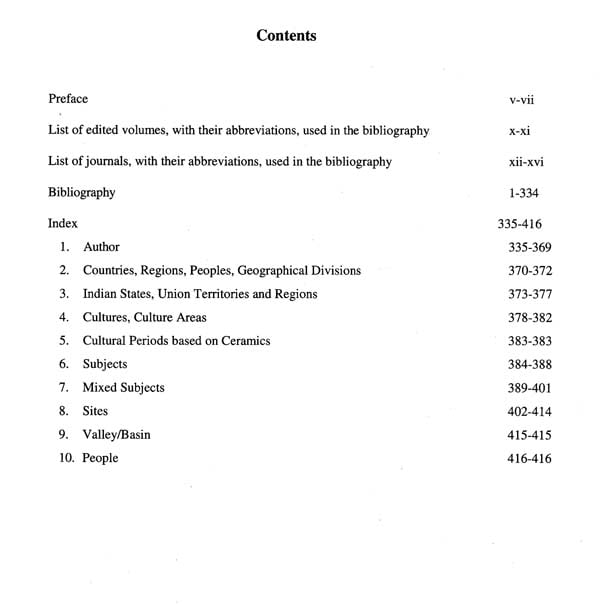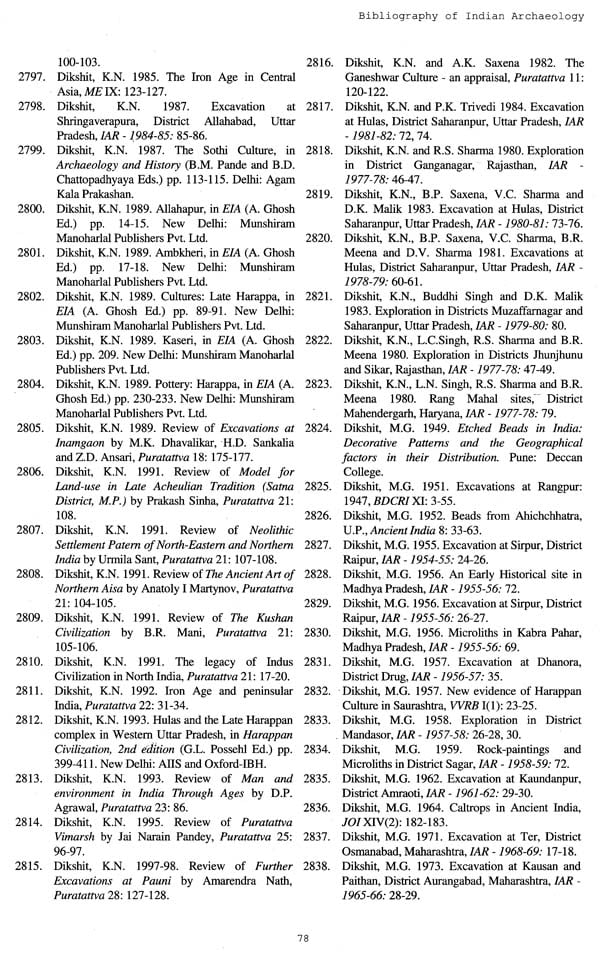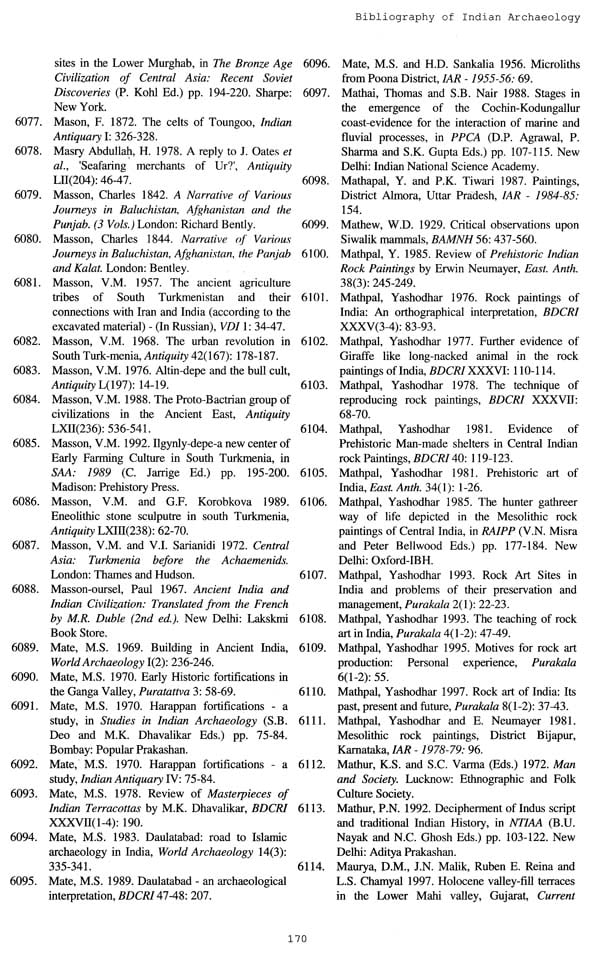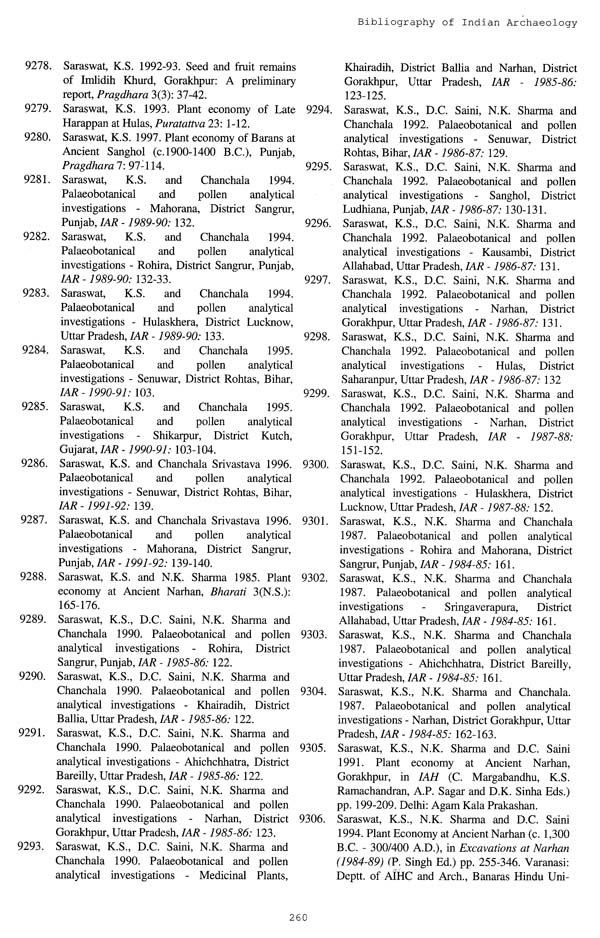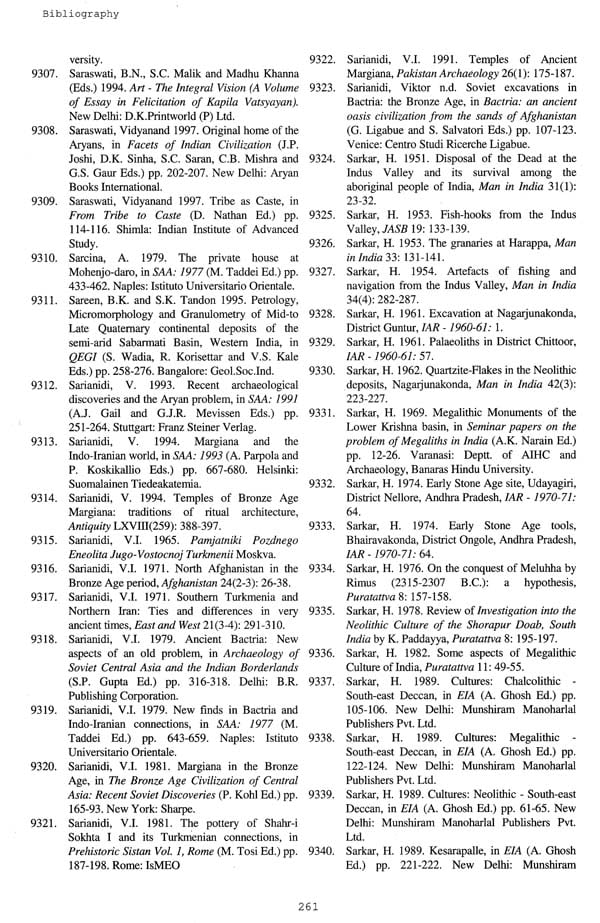
A Bibliography Of Indian Archaeology (Prehistoric, Protohistoric And Early Historic Periods)
Book Specification
| Item Code: | NAW973 |
| Author: | V. N. Misra And A. K. Kanungo |
| Publisher: | ARCHAEOLOGICAL SURVEY OF INDIA |
| Language: | English |
| Edition: | 2011 |
| Pages: | 417 |
| Cover: | HARDCOVER |
| Other Details | 11.00 X 8.50 inch |
| Weight | 1.51 kg |
Book Description
I am very happy to place before the discerning readers the Bibliography of Indian Archaeology on Prehistoric, Protohistoric and Early Historic Periods prepared by Prof. V.N. Misra and Dr. A.K. Kanungo. The invaluable contribution of the task of preparation of a Bibliography cannot be overemphasized. With the continuing and constant increase of the sum total of our knowledge in Archaeology and History, it is only fitting that there is a corresponding and persistent endeavour to update and make comprehensive the existing bibliographies on the subjects. As stated in the preface, there are a number of Bibliographies but most of them are of specialized nature and outdated. I am sure that this Bibliography would greatly benefit research and mark a milestone in our attempt to comprehend India's past.
One of the handicaps from which Indian researchers in Archaeology suffer is lack of bibliographic resources. There are a number of bibliographies, but most of them are of a specialized nature, and are outdated. These comprise one of archaeology from the beginning to the 1930s by P.C. Das-Gupta (1931), one of archaeology of Central India by H.V. Trivedi (1953), one each of the Indus or Harappan civilization by B.M. Pande and K.S. Ramachandran (1971), R.H. Brunswig, Jr. (1973), R.N. Dandekar (1987), A.K. Roy and N.N. Gidwani (1982) and G.L. Possehl (1999), and one each of Megalithic (1971) and Neolithic cultures (1980) by K. S. Ramachandran, one four of Numismatics by S.J. Mangalam (1989), Bal Krishan, M.A. (1968), C.R. Singhal (1952) and P.L. Gupta (1955, 1977, 1979); one of Ashokan inscriptions by M.A. Mehendale (1948); Epigraphy by Sibadas Chaudhuri (1966) each; and Pakistan Archaeology by Denise E. King (1975). There is only one bibliography which covers many though not all the branches of Indian Archaeology. This is Annual Bibliography of Indian Archaeology (ABIA) published by the Kern Institute, Leiden, and of which 23 volumes have so far been published. The first volume was based on 1926 data and published in 1928 and the last volume i.e., 23rd was published on the data of 1970-72 in 1984. In their new version two volumes published by the Institute comprises of index titled as ABIA South & Southeast Asian Art & Archaeology Indexs in 2002.
South Asia covers: Bangladesh, Bhutan, India, Nepal, Pakistan, Sri Lanka and the Maldives; Southeast Asia covers Brunei, Darussalam, Cambodia, Indonesia, Laos, Malaysia, Myanmar, The Philippines, Singapore, Thailand, and Vietnam. Besides, the bibliography covers areas like Southwest Asia (e.g., Afghanistan and Iran); Central Asia as related to South Asia (e.g., Uzbekistan and Tadjikistan); East Asia as related to South Asia (e.g. the region of Tibet), East Asia as related to Southeast Asia (e.g., South China), and the Pacific as related to South-East Asia (the region of Austronesian culture).
The online database of the bibliography covers a vast number of entries, probably, running into a million or more and can be accessed by any one. The printed volumes, however, include less than 0.1% of the online entries. The data for the bibliography has been collected from around 375 professional journals and serious popular magazines like Frontline and India Today in major European, South Asian, Southeast Asian and Central Asian languages, and edited works like felicitation and commemoration volumes and conference proceedings published in some forty languages. The subjects covered by the bibliography comprise prehistory, protohistory, historical archaeology, art history, epigraphy, palaeography, numismatics and sigliography (seals). The online data is accessible only to those having internet facility, and the published volumes have a limited number of entries in them. Thus there is a need of a comprehensive bibliography which can be accessible to most of the researchers.
V.N. Misra (VNM) realized this lacuna while doing his own research and supervising that of his Ph.D. students. He found that all researchers spend a good deal of their time on collecting bibliographical references, often from secondary sources like Ph.D. theses and, published works of not very conscentious authors. These sources often lack accuracy in respect of the titles of books and journals, year of publication, volume and issue number of journal and page numbers of articles.
There are also other constraints. Most of the Indian universities are young, having been established after Independence in 1947. Their financial resources are very limited and their library holdings very inadequate. They are unable to subscribe to important journals like Science, Nature, Scientific American, World Archaeology, Journal of Archaeological Science, Journal of Human Evolution, Journal of Anthropological Archaeology, Asian Perspectives, Geoarchaeology, L'Anthropologie, Journal of Quaternary Research and The Holocene. Fortunately, the library of the Deccan College Post-Graduate and Research Institute which was started in 1821 and with which VNM was associated for over forty years and Alok Kumar Kanungo for nearly twenty years, is able to subscribe to most of the important journals in Archaeology, Anthropology and Linguistics. It is also able to acquire most of the latest publications. Besides, it has a large collection of old Indian and foreign journals and books including gazetteers of the Imperial and District series, and Survey of India maps.
VNM had been thinking of preparing a bibliography of Indian archaeology for several years but could not start the work due to preoccupation with the administration of the Institute and his academic commitments. The opportunity arose in 1997 when Prof. S. Settar, then Chairman of the Indian Council of Historical Research (ICHR), during a visit to the Institute, asked Profs. K. Paddayya and VNM to prepare volume of edited papers and, bibliography of Indian Archaeology. Dr. Paddayya who took up the work of editing the volume and completed in two years. It was published by the ICHR and Manohar Publishers.
VNM began work on the bibliography in 1997. He selected and tick-marked in pencil all relevant articles in journals and edited volumes as well as books available in the Deccan College library. Besides, he selected entries from the references in other important articles and books. The number of entries selected was over 12,000. The work of making entries was stopped in June 2000 as VNM was due to retire from the Institute in August and had to wind his work. Ms. Vaishali Walunjkar and Mrs. S.B. Kunte typed the entries in Wordstar programme. Dr. Sushama Deo and Mr. Sandeep Bhonde prepared a programme for arranging the entries in an alphabetical order. Most of the entries pertain to India but there is a small number which pertain to neighboring countries like Pakistan, Afghanistan, Bahrain, Iran, Iraq, countries of Central Asia, Sri Lanka, Bangladesh, Myanmar, Nepal, Egypt and. Thailand with which India had cultural contacts for a long time. The time span covered by the entries extends from the Pliocene to the Early Historic period, i.e., the end of the Gupta period. Besides pure archaeology the entries cover related topics like late Tertiary, and Quaternary geology, palaeoenvironment, palaeoclimate, hominid evolution, palaeontology, archaeozoology, archaeobotany, palynology, dating, ethnography and ethnoarchaeology. It was not always possible to differentiate between the last two and so both these have been grouped into one. There are about a hundred subjects or topics. The bibliography is limited to Prehistory, Protohistory and Early Historic archaeology primarily of India. The entries have been classified according to subject, states and union territories of India and according to countries of the region outside India. The Central Asian republics have been grouped together under Central Asia while countries of the Middle East have been grouped together under West Asia. All the entries were serially numbered in five digit numbers alphabetically according to the names of the authors. The entries were to be classified under (1) explored and excavated sites, (2) subjects like palaeoclimate and palaeoenvironment, archaeological chemistry, archaeological metallurgy, pottery, dating and so on for States and Union Territories of India and neighbouring countries which had cultural contacts with India.
The lists of journals and edited volumes selected for making entries, subjects of entries, States and Union Territories of India, and other countries, with their abbreviations, are given in appendices after this preface.
Further work on the bibliography like editing of the entries and their classification according to subjects and administrative territories was shelved after VNM's retirement from the Deccan College on 31 August, 2000 due to several reasons. He had to shift his residence from the Deccan College to his own apartment in the city. More importantly, he was awarded two fellowships one after the other - 1. National Fellowship of the Indian Council of Historical Research (ICHR) in July 2000 and 2. Emeritus Fellowship of the University Grants Commission (UGC) in 2003. In between he was entrusted the responsibility of carrying out a project on Archaeological Research Methodology by the ICHR in addition to his regular work of editing Man and Environment, journal of the Indian Soceity for Prehistoric and Quaternary Studies, contributing papers and reviews to journals, refereeing papers submitted for several journals. Besides, he developed health problems in 2003. In addition to these commitments and problems he lost his only son in May 2006 and his wife in July 2007. Following these tragedies VNM had to move to Nairobi to stay with the family of his daughter. As a consequence of these happenings the pace of work slowed down.
VNM was, however, able to complete the National Fellowship project on the Prehistoric and Early Historic Foundations of Rajasthan in 2006 and it was published by Aryan Books International in June 2007. He also completed the project of Archaeological Research Methodology in March 2005, and UGC Fellowship project on Evolution of Indian Society in November 2008.
VNM was able to resume work on Bibliography project only in December 2008 after returning to India. The main work at this stage was (a) deletion of duplicate entries, (b) checking of missing details, (c) correction of errors in the entries, (d) classification of entries according to the criteria mentioned above, and more importantly (e) since the computer software in which the data was entered had become obsolete to make the indexing. Dr. Kanungo did these most time consuming and patient jobs. In the process the work developed many fold both in its layout and further indexing.
We are aware that there are some deficiencies in the bibliography. New States of Uttarakhand, Chhattishgarh and Jharkhand were carved out of Uttar Pradesh, Madhya Pradesh and Bihar respectively. New districts have been carved out of existing districts in several states and often the district names have been changed. We have retained the names of the districts in which the sites were reported. Therefore it has not always been possible to precisely specify the districts and states of some entries. This is mainly because many sites have been reported in the Indian Archaeology: A Review, a annual publication of the Archaeological Survey of India just by village name and district and sometime there are several villages of the same name in a district. As geo-coordinates of the sites are not given, it is not possible to find-out their exact location and the districts to which they belong. Also, many times sites have been simply mentioned as 'ancient mound' or 'stone tools'. Thus it is not possible to find out the precise cultural period of the site like Prehistoric, Early Historic, Late Historic or Medieval, and we have classified such sites only as historic or stone age. Whenever there are two names or spellings of a site we have retained both of at the first occurrence but used the more popular one at subsequent occurrences: examples Kusinagara/Kasia; Mahurjhari/Mahurzari.
We have used the terms Middle Palaeolithic for Middle Stone Age and Mesolithic for Late Stone Age because the latter terms were used only for a few years in the 1960s and 1970s and given up afterwards. Also, to maintain consistency we have used the term Indus Civilization in place of Harappan. The bibliography is largely related to explored and excavated sites from the Stone Age to the Early Historic time and covers only topics related to field archaeology. Entries on subjects like architecture, art, numismatics, palaeography and epigraphy are limited only to explored and excavated sites. We hope, however, that despite these limitations the bibliography will be useful to researchers by providing them information on particular topics, districts, states and union territories and only countywise in the case of countries other than India as it existed in June 2000 when the work of making entries was stopped. We hope some other researchers will come forward to update the bibliography periodically.
We are indebted to a number of institutions and individuals for their help in preparing the bibliography: the ICHR and its then Chairman, Prof. S. Settar for asking VNM to undertake the project; Ms. Vaishali Walunjkar and Mrs. S.B. Kunte for typing the entries; Dr. Sushama Deo and Mr. Sandeep Bhonde for help in computer programming; Mr. M.K. Kulkarni, Mr. R. Shigwan and Mrs. Trupti More, successive Librarians of the Deccan College and their colleagues for providing publications from the library; Mrs. More finding the missed reference details in proof reading stage; Drs. Shahida Ansari, Shanti Pappu and Kumar Akhilesh for bringing publications from library to VNM's home; and Dr. Ansari facilitating Alok to concentrate on finishing this work in one of the difficult stages of her life.
Besides working on his Fulbright and Homi Bhabha Fellowship Projects Dr. Kanungo has used a lot of his time both in the Deccan College and Wisconsin-Madison Memorial Libraries for making the corrections; checking the references and making the index. He gratefully acknowledges support of the Fulbright and Homi Bhabha Fellowship Councils.
We are thankful to the Archaeological Survey of India for publishing this bibliography
**Contents and Sample Pages**
